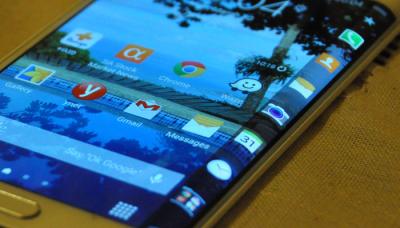Super AMOLED: introduction and market status
OLED displays use organic materials that emit light when electricity is applied. OLEDs enable emissive, bright, thin, flexible and efficient displays. OLEDs are replacing LCDs in most display applications - from smartphones and wearables to monitors and TVs.

Samsung's Super AMOLED displays, announced in 2010, are AMOLED displays for mobile devices (such as smartphones, wearables and tablets) with an integrated touch function. The thickness of the touch sensor is just 0.001 mm and this allows the screen to provide better images and to have great visibility even in direct sunlight compared with regular AMOLED displays with an external touch layer.
Samsung is producing hundreds of millions of Super AMOLED displays today, used mostly in smartphones, but also in other devices. These are considered to be some of the best displays on the market.
Super AMOLED and the Pentile matrix
Samsung's Super AMOLED displays use a Pentile matrix sub-pixel design. That means that the green sub-pixel is shared by two pixels and the display has only 2 sub-pixels per real 'pixel' compared to the classic RGB matrix design (or Real-Stripe). You can see a PenTile matrix vs a Real-Stripe one on the images below (the PenTile is on the right). Newer Super AMOLED displays use a different PenTile matrix (Diamond Pixel pattern).
Super AMOLED vs Dynamic AMOLED
In 2019 Samsung introduced its next-generation mobile display technology, which it calls Dynamic AMOLED. Basically a Dynamic AMOLED is similar to a Super AMOLED display, but it adds HDR support. Samsung's highest end smartphones adopt the company's Dynamic AMOLED 2X LTPO AMOLED displays.
Further reading
- Introduction to OLEDs
- Samsung's OLED displays
- Pentile Technology explained
- Flexible OLEDs
- OLED mobile phones
- The OLED Toolbox: a one-stop-shop for OLED information, insights, analysis and guides
Toshiba Mobile Display developed a 7" LTPS LCD with an integrated in-cell touch panel
Toshiba Mobile Display developed a 7" LTPS TFT LCD panel that has an integrated in-cell touch panel. The new LCD is only 1mm thick (about 57% thinner than a LCD with an external touch panel) and weights only 225 grams (48% less than an external-touch LCD). The integrated touch panel also reduces the surface reflection ratio by about 10%. This is basically the same technology that Samsung uses in their Super AMOLED displays.

We don't know when TMDisplay plans to actually produce such panels. They will show this technology next month at SID 2011.
A video of a Super AMOLED display under a 100X microscope
Here's a nice video showing Samsung's Super AMOLED display under a 100X microscope (the device is a Samsung Focus phone):
You can see that this display uses a PenTile subpixel matrix (in which the (smaller) green subpixel is shared between two pixels). Samsung's upcoming Super AMOLED Plus no longer uses a PenTile.
LG's NOVA LCD, a Super AMOLED and a Retina Display compared
Here's a nice video showing LG's new NOVA LCD display side by side with a Super AMOLED (a Galaxy S phone) and Apple's iPhone 4 Retina Display (which is also an LCD). LG says that the NOVA displays are 50% brighter than the LCD and will consume about half the power than an AMOLED display on a white screen.
LCD vs Super AMOLED vs Super AMOLED Plus
Samsung released a short video showing the difference between an IPS-LCD (as used in Apple's iPhone 4), a Super AMOLED and the new Super AMOLED Plus:
Super AMOLED Plus displays are an upgrade to Super AMOLED. They use a real-stripe subpixel matrix and not pentile - and so has 50% more sub-pixels. The PPI is a bit larger but Samsung will soon make them at much higher resolutions. Super AMOLED Plus displays are also thinner, brighter and use 18% less energy than the older Super AMOLED displays.
Super AMOLED Plus vs Super AMOLED video
We've got a lot of Super AMOLED Plus news today. Here's a short video comparing the Galaxy S2 (with its 4.3" Super AMOLED Plus display) to a Galaxy S (4" Super AMOLED) and an iPhone 4 (3.5" IPS-LCD). The most apparent thing about the S2 - it's a big phone...
Super AMOLED Plus resolution explained
Update: We have some new information about Samsung's AMOLED manufacturing process. It turns out that they plan to soon move to a laser-based method (LITI) from the currently-used shadow-mask method (FMM). This will allows them to achieve 300ppi or more...
Earlier today we posted about the Super AMOLED plus resolution - and now we got our answer. It turns out that my calculations about the pentile matrix were incorrect - it fact it uses 2 sub-pixels for each pixel while a 'real' RGB matrix (or Real-Stripe as Samsung calls it) uses 3 sub-pixels for each pixels - and here's your 50% increase. Here's Samsung's own image showing the difference:

It also turns out that a Real-Stripe matrix also takes up more space per pixel. This explains why a 4.3" display that uses Real-Stripe has the same resolution as a 4" with a penTile matrix. But this display should actually be clearer because of the added sub-pixels and better matrix design.
Super AMOLED Plus resolution mystery?
Update: We now got the answer to this little mystery, you can read it here.
Samsung's new Galaxy S2 phone has a Super AMOLED Plus display but something is strange about the resolution of this phone. It's a 4.3" panel with 800x480 resolution (WVGA). That's the same resolution found on the original Galaxy S that has a 4" Super-AMOLED. When Samsung announced the Super AMOLED Plus they said that it offers 50% more sub-pixels and offers over 300ppi.
| |
The original Super AMOLED used Samsung's PenTile Matrix scheme (shown above on the right) - which uses a shared green pixel (RGBG). The Super AMOLED Plus displays uses a regular RGB matrix (shown above on the left). That means that you need more subpixels to show the same amount of pixels - indeed a pentile matrix uses 33% less pixels (for example a 4X4 RGB display will use 48 subpixels while a 4X4 RGBG pentile will use only 36 subpixels).
Samsung drops the Super-AMOLED displays in the "new" Galaxy SL phone
Samsung announced a new phone - the Galaxy SL. It's very similar to the Galaxy S in fact the only differences are an LCD display instead of the Super AMOLED and a TI OMAP 3630 processor instead of Samsung's own Hummingbird (both 1Ghz processors).

We're not really worried here - we know that Samsung still has AMOLED supply issues (even the Nexus S is shipping with LCD in some countries) - and we know that the new flagship phone (the Galaxy S2?) will have a Super AMOLED Plus displays...
Samsung confirms a Galaxy S successor with a dual-core processor and a Super AMOLED Plus display
 Samsung reported strong financial results, with over 80 million mobile devices shipped in the fourth quarter of 2010. In their financial report, Samsung also confirms they will ship a new phone that will be the Galaxy S successor during the first half of 2011, and this device will have a dual-core processor and a Super AMOLED Plus display. This will probably be the Galaxy S2, leaked a few weeks ago.
Samsung reported strong financial results, with over 80 million mobile devices shipped in the fourth quarter of 2010. In their financial report, Samsung also confirms they will ship a new phone that will be the Galaxy S successor during the first half of 2011, and this device will have a dual-core processor and a Super AMOLED Plus display. This will probably be the Galaxy S2, leaked a few weeks ago.
With regards to tablets, Samsung says that they have sold over 2 million Galaxy Tab devices in three months, and they plan to release a 'number of versions' in 2011. Will some of these use an OLED display?
Samsung Galaxy Tab 2 video leaked - to have a 2048x1200 7" Super-AMOLED display?
Update: The Galaxy Tab 2 is now official, here's more details along with the new Galaxy S2 phone.
Update: We understand that Samsung wants to introduce the Galaxy Tab 2 soon, and it's not clear whether they'll be able to actually deliver 7" Super-AMOLED displays in time - some say that it will use an LCD like the original Tab. It's not clear also whether this video is real or is this a fake...
We found a "leaked" video announcing the upcoming Samsung Galaxy Tab 2. The leaked specs include a 7" 2048x1200 Super-AMOLED display (which is probably a Super AMOLED Plus, really, because of that resolution). Samsung unveiled a 7" Super-AMOLED in a tablet prototype back in November 2010, so this isn't a huge surprise. Here's the video:
Pagination
- Previous page
- Page 18
- Next page



